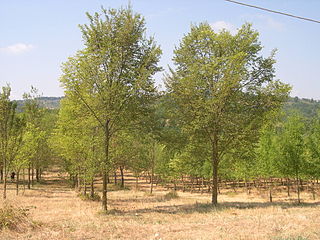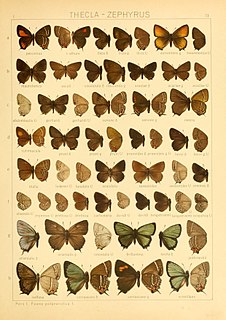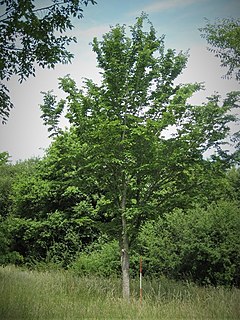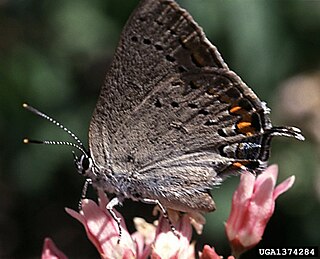
The brown hairstreak is a butterfly in the family Lycaenidae. The range includes most of the Palaearctic.

The purple hairstreak is a butterfly in the family Lycaenidae distributed throughout much of Europe, North Africa, Anatolia, Caucasia, and Transcaucasia. The larva feeds on Quercus robur, Quercus petraea, Quercus cerris and Quercus ilex.

The black hairstreak is a butterfly in the family Lycaenidae.

Ulmus 'Nanguen' is a complex fourth generation Dutch hybrid cultivar raised at the Dorschkamp Research Institute for Forestry & Landscape Planning, Wageningen. Lutèce was derived from the cross 'Plantyn' ×, an ancestry comprising four field elms, a wych elm, the curious Exeter Elm ('Exoniensis'), and a frost-resistant selection of the Himalayan elm.

Ulmus 'New Horizon' is an American hybrid cultivar raised by the Wisconsin Alumni Research Foundation (WARF), from a crossing of the Japanese Elm clone W43-8 = 'Reseda' with Siberian Elm clone W426 grown from seed collected from a street tree at Yankton, South Dakota. Tested in the US National Elm Trial coordinated by Colorado State University, 'New Horizon' averaged a survival rate of 74% after 10 years.'New Horizon' was patented in the US in 1994, while in Europe, it is marketed as one of the 'Resista' elms protected under EU breeders' rights.

Ulmus 'Sapporo Autumn Gold' is one of the most commercially successful hybrid elm cultivars ever marketed, widely planted across North America and western Europe, although it has now been largely supplanted by more recent introductions. Arising from a chance crossing of the Japanese elm and Siberian elm, seed was sent in 1958 by Prof. Nobuku Takahashi and his colleagues at the Sapporo Botanical Garden of Hokkaido University, Sapporo, to Eugene Smalley at the University of Wisconsin–Madison. The patent issued in 1975 has expired, and there are now no propagation restrictions.

Ulmus 'Wanoux' is a Dutch hybrid cultivar raised at the Dorschkamp Research Institute for Forestry & Landscape Planning, Wageningen, from an open pollination of 'Plantyn'. Originally identified as clone No. 762, it was selected for assessment by the French Institut National de la Recherche Agronomique (INRA), which patented it as 'Wanoux' in 2006.

Ulmus 'Arno' is an Italian hybrid cultivar derived from a crossing of 'Plantyn' with the Siberian Elm Ulmus pumila clone S.2. It was raised by the Istituto per la Protezione delle Piante (IPP) in Florence, and released in 2007. However, 'Arno' was not a commercial success; propagation had ceased by 2010, and it is no longer patent protected.

Ulmus 'Fiorente' is a hybrid cultivar elm derived from a crossing of the Siberian Elm Ulmus pumila clone 'S.10' from Lucca, Italy, with the Ulmus minor clone 'C.02' from Lungarno, Florence, by the Istituto per la Protezione delle Piante (IPP), part of the Italian National Research Council, in Florence. 'Fiorente' was patented in 2006, and released to commerce in 2012.

Satyrium spini, the blue spot hairstreak, is a butterfly in the family Lycaenidae.

Satyrium ledereri, the orange banded hairstreak, is a butterfly in the family Lycaenidae.

Ulmus 'Morfeo' is a hybrid elm cultivar raised by the Istituto per la Protezione delle Piante (IPP), Florence, in 2000. 'Morfeo' arose from a crossing of the Dutch hybrid clone '405' and the Chenmou Elm, the latter a small tree from the provinces of Anhui and Jiangsu in eastern China, The '405' clone is a full sister of 'Groeneveld', a crossing of an English U. × hollandica and a French U. minor from the Barbier Nursery, Orléans.

Satyrium californica, the California hairstreak, is a butterfly of the family Lycaenidae. It is found from British Columbia south to southern California and east to Colorado.

Satyrium favonius, the oak hairstreak or southern hairstreak, is a butterfly of the family Lycaenidae. It is found in the United States from southern New England and the Atlantic Coast south to peninsular Florida and west to central Illinois, south-eastern Colorado and the Gulf Coast.

Satyrium acadica, the Acadian hairstreak, is a butterfly of the family Lycaenidae. It is found in North America from British Columbia east to Nova Scotia and south to Idaho, Colorado, the northern Midwest, Maryland, and New Jersey.

Satyrium behrii, the Behr's hairstreak, is a butterfly of the family Lycaenidae. It is found in western North America from western Texas north and west through New Mexico, Arizona, and southern California to British Columbia.

The sylvan hairstreak is a butterfly of the family Lycaenidae. It is found in western North America, from British Columbia south-east to Wyoming, Colorado and New Mexico and south through California to Baja California Norte.

Satyrium liparops, the striped hairstreak, is a butterfly of the family Lycaenidae described by John Eatton Le Conte in 1833. It is found in North America, from the Rocky Mountains south from southern Canada to Colorado, east to Maine and south to Florida.
Satyrium polingi, or Poling's hairstreak, is a butterfly of the family Lycaenidae. It was described by William Barnes and Foster Hendrickson Benjamin in 1926. It is found in North America from southern New Mexico and western Texas south to north-eastern Mexico. The habitat consists of oak woodlands.

Satyrium caryaevorus, the hickory hairstreak, is a butterfly of the family Lycaenidae. It is found in eastern North America, from southern Ontario west to Minnesota and Iowa, south in the Appalachian Mountains to eastern Tennessee.

























